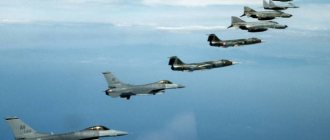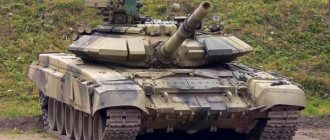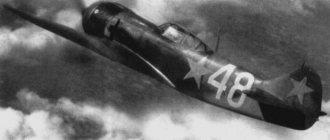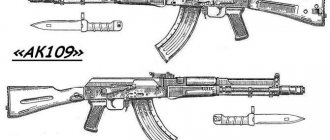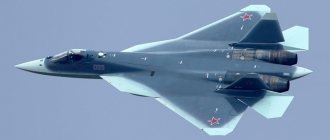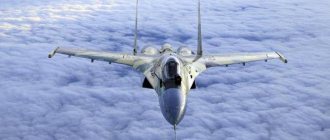Comparison of flight performance characteristics of the MiG-35 and Su-35
Before talking about which aircraft is better, it is necessary to compare the technical characteristics and combat capabilities of both. Let's look at what these two fighters are and what combat missions they can handle.
MiG-35
An advanced representative of the fighter class. Capable of fighting American fifth-generation aircraft. After all, its equipment exactly corresponds to this class of aircraft, since Russia initially developed the MiG 1.44 MFI (fifth generation aircraft) in response to the release of the F-22. However, later, due to a lack of funding, its production was suspended, and based on existing projects, a completely new type of modern military vehicles for air combat was designed.
The aircraft has a length of 17.3 meters, a maximum take-off weight of 29.7 tons, a combat load of 7 tons, a maximum speed of 2.5 thousand km/h, and a practical range of 3,000 km. It is equipped with a Zhuk-AE radar with an active phased array antenna and has a fly-by-wire control system. Can detect the launch of an enemy missile and track its movement. Its radars are capable of seeing an aerodynamic target already at a distance of 200–260 km. The combat radius of such a vehicle is 1,000 km. In terms of rate of climb, it has no equal - as much as 330 m/s.
Armament composition: built-in GSh-30-1 30 mm cannon, 10 hardpoints, R-73, R-27, RVV-AE. The fighter is equipped with modern anti-ship and anti-radar missiles and the latest air-class missiles. It also has adjustable bombs and aircraft mines.
Su-35
This is a heavy fighter. It, unlike the light MiG-35, can fight and defend territory from the enemy, and dictate its terms to the enemy. He is even able to defeat the representative of the fifth generation - the “American” F-22.
The length of the aircraft is 21.9 m, the maximum take-off weight is 34.5 tons, the combat load is 8 tons. Maximum speed is 2.5 thousand km/h, non-stop distance is 3,500 km, rate of climb is 280 m/s, combat radius is 1,800 km. The distance from which the target will be detected is 400 km.
Uses the Irbis radar, OEIS, as well as an optical location station. Equipped with electronic warfare and protection systems. Has missile attack warning sensors.
Armament: GSh-30-1 aircraft cannon, 12 hardpoints. Missiles: R-27, R-73, RVV. Equipped with the latest air-to-ground technology and precision-guided munitions. Simultaneous firing is carried out by 8 missiles with an active homing head and 2 semi-active GS missiles.
Missing time
The more expensive and heavier fellow competitor of the MiG, the Su-27, was little known in the Soviet years and was not exported (the first contract was concluded with China back in the USSR, but deliveries had already begun in Russia), but in its modernized versions it became a real a global bestseller and a symbol of modern Russian aviation. The MiG-29, on the contrary, was popular in the 1980s, was actively supplied to friendly countries, for a long time in Western culture remained synonymous with a Russian-made fighter (usually in the hands of enemies of the brave protagonists of films and games), but after the collapse of the USSR it did not gain much success.
In many ways, the reasons for the success of the Sukhoi were the active, proactive and courageous work on the development and promotion of vehicles in a new, deeply modernized look, which was carried out jointly by the design bureau, Irkutsk and Komsomol aviation after a successful and, without any doubt, breakthrough for the Russian defense industry contract with Malaysia in 1994 appears to have rested on its laurels, leading to key potential markets being occupied by Sukhoi's heavier fighters.
MIG_01
Soviet multirole fighter of the fourth generation MIG-29, 1988
Photo: RIA Novosti
It also played a role that in the 1990–2000s, Soviet-made MiG-29s were actively sold out of the air forces of Belarus and Ukraine, with which it was difficult for new production vehicles to compete on price. It seemed that the 2006 contract with Algeria, which interrupted this pause, for a new modification of the MiG-29SMT with updated avionics (avionics) and a significantly increased fuel supply (the most noticeable difference of this modification was the large “hump” of the overhead fuel tank behind the cockpit) turned into an unpleasant scandal - the customer accused of selling used cars or assembled from unused stock under the guise of new ones. As a result, in order to quell the scandal, the fighters had to be bought back (they were transferred to the Russian Air Force), and the Algerians purchased several batches of Su-30MKA.
This music will last forever
India will never stop wanting to buy a hundred fighters
It would not be a great exaggeration to say that the future of the MiG-29 family was saved by Indian aircraft carrier ambitions. Having acquired the aircraft-carrying cruiser Admiral Gorshkov from Russia in 2004, which after modernization, primarily consisting of equipping it with a ski-jump and arresting arresters, received the name Vikramaditya, the Indian Navy had to purchase suitable fighters for it. The deck version of the MiG-29 was a natural choice: it was smaller and lighter than its only real competitor, the Su-33, which was critical for a much smaller Indian aircraft carrier than the Admiral Kuznetsov. In accordance with Indian requirements, a new carrier-based version of the fighter was developed, which is important not to be confused with the one tested during Soviet times. The airframe was radically updated, the fuel supply was increased, the avionics were updated and the arsenal of weapons was expanded, now placed on eight hardpoints instead of six. A unique feature of the MiG-29K/KUB (single and double versions, respectively) is that it always, regardless of the number of seats, has a long, “double” cockpit canopy. The single-seat version houses an additional fuel tank instead of a co-pilot.
India purchased 45 fighters under two contracts, which is enough to form the Vikramaditya air group and the slightly smaller Vikrant, which is under construction, which is built according to a similar scheme to Russian ships (which is not surprising, since it was also designed by Nevsky design bureau). Following this, the Indians plan to build a heavy Vishal - this time with electromagnetic catapults. But given the extremely slow pace of construction and the terrible delays with Vikrant, it is doubtful that these dreams will come true before the 2030s.
MIG_01
MiG-29K aircraft of the Indian Navy on the deck of the aircraft carrier Vikramaditya
Photo: REUTERS/Shailesh Andrade
It is important for the Russian side that once again, as with the Su-30MKI, it was possible at Indian expense to develop, test and launch a machine useful for itself. A contract was signed for the Russian Navy in 2012 for 24 vehicles, which were delivered in subsequent years. This became a much more practical purchase than the contract concluded in 2014 for 16 less advanced MiG-29SMT, which, against the backdrop of dozens of Sukhoi purchases and the finally emerging unification of the tactical aircraft fleet of the Russian Air Force, looked like too obvious “manufacturer support.”
Fighter Bazaar
What will the Indian Air Force fly?
Even more useful was the fact that the MiG-29K/KUB became not just a deck-based vehicle - in this incarnation it would obviously have a very small market, but the basis for the new generation of Twenty-Niners. First of all, the MiG-29M/M2, actually a land-based modification of the K/KUB, differing only in the absence of specific systems necessary for sea-based deployment. Egypt purchased fifty vehicles in this guise, which became the largest contract for the MiG corporation in many years. In order to interest the Russian Defense Ministry and other potential buyers, it is proposed to develop this vehicle under the already traditional name MiG-35.
Expert opinion
If you compare these two fighter models, you can find a lot in common. These are the latest modifications of Soviet classic aircraft - the Su-27 and MiG-29. Multi-role fighters and bombers are capable of gaining superiority in the skies overnight and striking with bombs and missiles against ground and sea targets. They have almost the same combat load and are capable of performing similar combat work.
Previously, the Russian Air Force was mainly armed with MiG-29 and Su-27. The time has come to replace outdated combat vehicles with new ones. Su-35 combat vehicles are also in service with the Russian Air Force. True, these fighters are much more expensive than light aircraft and are used only for long-range combat. In addition, in battle it is easier to sacrifice an inexpensive fighter.
The Ministry of Defense of the Russian Federation is going to create the main fist of combat aviation on the basis of new “instants”.
Both aircraft have a number of technical and combat differences, which determine their operational characteristics. "MiGs" are slightly smaller than "Sushki", they can carry less weapons on board. They have fewer suspension points, as a result of which they are less able to take bombs and missiles. "MiGs" have lower radar parameters for target detection. True, the reduced weight capabilities allow them to develop greater speed than “dryers” can afford.
MiGs give Russian troops more flexibility and have a high rate of climb. "Su-shki" are considered heavy fighters, capable of defending their territory and blocking the sky above it for enemy aircraft. Both vehicles are equally needed by the Russian Air Force. According to experts, although these aircraft have almost the same functionality, they are intended for different purposes.
Which fighter is stronger?
MiG-35Su-35
A little history
Historically, during the Soviet Union, air fighters from the Mikoyan and Sukhov companies each carried out their clearly defined tasks. The MiG-29s located at the airfields of the GDR were supposed to, as the fastest and most maneuverable machines, take the first blow in the outbreak of the European war and withstand it or die heroically, justifying the meaning of the concept of “light front-line fighter”.
, the Su-27 was kept away from NATO troops. These aircraft were located on the territory of Ukraine and Poland, in air defense combat units and were supposed to guard the airspace above our troops in the decisive battle. As a result, the Su-27 received the designation of a heavy fighter designed to gain air superiority.
This was confirmed by the tactical and technical characteristics of these aircraft. The Mig-29 was capable of taking a combat load of only 2180 kg versus 6 tons for the Su-27 and could operate within a radius of no more than 700 km, while the Sukhov vehicle had a combat radius of about 1700 km.
conclusions
Light fighters are preferable to take into service. They are cheaper. Serial production is not as complex and expensive as the production of heavy combat vehicles. For some targets, it is not advisable to use overly expensive Su missiles. If both fighters can cope with the task with equal effectiveness, then it is better to take the MiG into the sky than the Su, which is expensive to maintain and operate.
Light fighters are a workhorse, designed specifically for close-range combat. Thanks to "instants" you can get the desired result at lower costs. Su-35s are considered expensive aircraft. They are used, as a rule, to protect their territory and to conduct a full-fledged military battle at a great distance. The Russian Air Force needs both aircraft, since the workload of the flight fleet is very low compared to the US Air Force. The likelihood of a confrontation between these two countries is low. However, Russian fighters will be involved in battles in the skies and over the territory of other countries.
Export opportunities
It is quite obvious that at the moment the MiG-35 will become the most affordable 4++ generation aircraft on the arms market. For states that cannot afford fighters such as the French Rafale, F-16 or even the Russian Su-35S , they need a simple, inexpensive 4++ generation aircraft, and the cheaper it is, the faster the deal will be concluded.
In the international market in recent decades, the Russian Su-27 has been in great demand, but whoever had the opportunity to already purchase this aircraft, somehow revive the market and sell a car of the same class as the Su-35 , but at a more attractive price, it is quite possible by offering MiG-35 with its multifunctional capabilities. Against the backdrop of the global economic downturn, this calculation will be correct.
In such a deal, you can’t count on China, and the countries of the Middle East, South American states and even India, which is very dissatisfied with the purchase of French Rafale aircraft and which needs to replace its fleet of outdated MiG-21s, will willingly purchase the inexpensive but promising MiG-35.
Although the cost of the MiG-35 is not announced, judging by the price of this machine at the Indian tender in 2007, it is less than $100 million, which is required for the French Rafale and lower than the cost of the US F-35A , then at least remains lower the price for which China bought Russian Su-35S .
